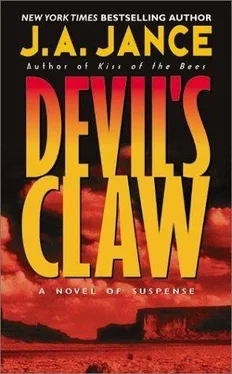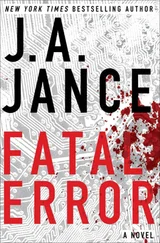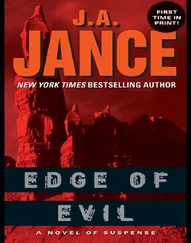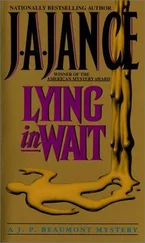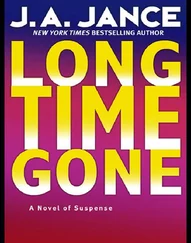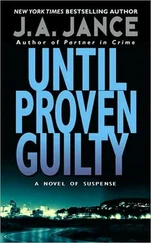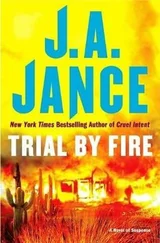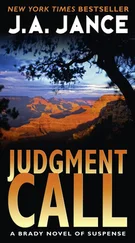J. Jance - Devil’s Claw
Здесь есть возможность читать онлайн «J. Jance - Devil’s Claw» весь текст электронной книги совершенно бесплатно (целиком полную версию без сокращений). В некоторых случаях можно слушать аудио, скачать через торрент в формате fb2 и присутствует краткое содержание. Жанр: Триллер, на английском языке. Описание произведения, (предисловие) а так же отзывы посетителей доступны на портале библиотеки ЛибКат.
- Название:Devil’s Claw
- Автор:
- Жанр:
- Год:неизвестен
- ISBN:нет данных
- Рейтинг книги:4 / 5. Голосов: 1
-
Избранное:Добавить в избранное
- Отзывы:
-
Ваша оценка:
- 80
- 1
- 2
- 3
- 4
- 5
Devil’s Claw: краткое содержание, описание и аннотация
Предлагаем к чтению аннотацию, описание, краткое содержание или предисловие (зависит от того, что написал сам автор книги «Devil’s Claw»). Если вы не нашли необходимую информацию о книге — напишите в комментариях, мы постараемся отыскать её.
Devil’s Claw — читать онлайн бесплатно полную книгу (весь текст) целиком
Ниже представлен текст книги, разбитый по страницам. Система сохранения места последней прочитанной страницы, позволяет с удобством читать онлайн бесплатно книгу «Devil’s Claw», без необходимости каждый раз заново искать на чём Вы остановились. Поставьте закладку, и сможете в любой момент перейти на страницу, на которой закончили чтение.
Интервал:
Закладка:
“Yesterday I tried to explain that what happened between her mother and father was the same thing that had happened between Big Red and the kitten. I told Lucy that Sandy did what she did to protect herself-to save her own life and Lucy’s.”
“What did Lucy say to that?”
“She said it was all a lie, that her father never hit anybody. After that, Lucy stormed off to her room and didn’t come out for dinner. This morning, when I got up, she was gone, along with her backpack, a bedroll, and some of her clothes.”
“Was anything else missing?”
“Some food from the kitchen, her bike…”
“And?”
Catherine bit her lip and didn’t answer.
“What else?”
“A gun,” Catherine answered reluctantly. “A twenty-two. It belonged to my husband. I keep it for protection-for snakes, that kind of thing.”
“Does Lucy know how to use it?”
“Yes. I taught her myself.”
“Did you tell Frank earlier this afternoon that the gun was missing?”
“No. I was afraid if I told him she was armed that it would keep people from looking for her.”
It wouldn’t keep them from looking, Joanna thought. But they’d be a hell of a lot more careful while they were doing it.
“What about Big Red?” Joanna continued. “Have you seen any sign of him today?”
“No.”
“So it’s possible he’s with her?”
“Probable more than possible, I’d say,” Catherine answered. “The two of them spend most weekends together. They ride over to the Stronghold.”
“Ride?” Joanna asked.
“Oh, yes. Big Red rides on her shoulder or her handlebars. He’s done that since he was just a baby. When they get to the park, Lucy climbs up and down the cliffs and Big Red usually sticks around somewhere nearby. Out of sight, maybe, but not far away.
“I tried to warn Lucy about that, by the way. There are so many other people hiking and camping up there that I told her it could be dangerous for him. I tried to explain that turning wild animals into pets is a bad idea because once they grow accustomed to humans, they may not be afraid when they ought to be. But of course, by the time I told Lucy that, it was already too late. And maybe it’s not as bad as all that. As far as I can tell, she’s the only person Big Red’ll have anything to do with. I can tell you, as soon as that bird catches sight of me, he flies off in a hurry.”
“Does Lucy drive?”
“No. She’s still too young to get a learner’s permit.”
“So you don’t think Big Red would get into a vehicle with her?”
“In a car? No. But on the bike, no problem.”
“Which means, if the bird is with Lucy, then wherever they are, they most likely traveled there on foot or by bicycle.”
Catherine Yates nodded, and Joanna turned to Frank. “What about Search and Rescue?” she asked.
“They’re aware of the situation,” Frank replied. “By morning the twenty-four-hour waiting period will be up. I’ve made arrangements with Mike Wilson to have a Search and Rescue crew here by first light in the morning if Lucy hasn’t been found by then.”
Joanna nodded. Departmental policy called for the passage of twenty-four hours before taking a missing-persons report or calling in Search and Rescue. There were exceptions to that rule, especially in the case of lost small children or wandering elderly Alzheimer patients. Lucy Ridder’s case fell in a gray area, unless she turned out to be a homicide suspect. In that case, all bets were off.
“Do you happen to have recent photos of your daughter and granddaughter?” Joanna asked.
“The one I have of Sandy is several years old, but I have last-year’s school picture of Lucy. Would that help?”
“Very much,” Joanna said.
“Well then,” Catherine Yates told her, “come on in. You might as well wait inside. It’s cold out here.”
Joanna and Frank trailed after Catherine as she led the way onto the porch.
“When are you going to get around to telling her?” Frank asked, under his breath.
“After we have the fax with the mug shot in hand,” Joanna whispered back. “I’d like to have a little more confirmation on that stolen Lexus before I blow this poor woman out of the water.”
Frank nodded. “Want me to go back to the car and wait for it? That way I can bring it inside as soon as it comes through.”
“Right,” Joanna said, then she followed Catherine Yates into the living room of her tiny square-shaped house.
Joanna recognized the design. Larry Yarnell Homes, an early edition of modular housing, had been marketed in the late sixties and early seventies as a relatively inexpensive form of pre-fab housing-one step up from mobile homes and one step down from permanent frame construction. Because they were less costly to build, Larry Yarnell Homes had sprouted like weeds in rural southern Arizona. Now, almost forty years later, most of those houses had outlived their useful lives. Made of generally shoddy materials, some were little more than moldering, burned-out hulks. This one, however, had clearly been well cared for and kept in good repair.
While Catherine Yates disappeared into the back of the house, Joanna stood in the middle of the living room and looked around. The carpeting on the floor was threadbare but clean. The same could be said for the collection of old-fashioned but still serviceable leather furniture. On the wall, over a long sofa, two gold-framed pictures broke the monotony of cheap oak paneling. One was the photo of a smiling Korean War-era GI standing with one foot resting on the bumper of a 1952 Mercury convertible.
The other photo-in faded sepia tones-depicted a man who appeared to be a full-blooded Indian standing proudly at attention and staring, solemn-eyed, into the lens of the camera. He wore some kind of uniform-one that was unfamiliar to Joanna.
“The one on the right is Carter, my husband. The one on the left is my great-grandfather,” Catherine Yates said, returning silently to the living room. “His name is Eskiminzin. Ever heard of him?”
Joanna shook her head.
“You should have. He was an Arivaipa Apache. He was also a chief, just like Cochise or Geronimo. Except he wasn’t a warrior. He was a man who wanted to get along with the whites. Even after most of his first family was murdered in the Camp Grant Massacre, he still tried to make peace. My great-grandmother, my mother’s grandmother, was his second wife.”
Joanna knew enough about Arizona history to have a nodding acquaintance with the Camp Grant Massacre. What history books called the “Apache Wars” would, in the modern vernacular, have been termed “ethnic cleansing.” Operating under the philosophy of “Manifest Destiny,” the United States Government had engaged the Apaches in a war of eradication designed to remove them from their ancient lands and make way for Anglo settlers.
Worn down by years of fighting, in 1871 several separate Apache bands had surrendered to the commanding officer at Old Camp Grant and sued for peace. Having been told that they could camp outside the fort under the protection of the United States Cavalry, the Apaches stayed there for the next two months while peace negotiations took place. Meanwhile, several Tucson-area merchants-Anglos every one-rounded up an expeditionary force made up of Mexicans and Tohono O’othham who had their own long-held grudges against marauding Apaches.
This band of mercenaries attacked the sleeping Apaches under the dark of night. Many of the younger men managed to escape into the hills, but women and children, along with the old and sick and helpless, were slaughtered where they slept.
“It was about this time of year,” Catherine said softly. “April thirtieth.”
Obviously, for Catherine Yates and her family, the Camp Grant Massacre wasn’t some distant, dusty footnote to history. It was still a hauntingly vivid and painful part of her family’s past.
Читать дальшеИнтервал:
Закладка:
Похожие книги на «Devil’s Claw»
Представляем Вашему вниманию похожие книги на «Devil’s Claw» списком для выбора. Мы отобрали схожую по названию и смыслу литературу в надежде предоставить читателям больше вариантов отыскать новые, интересные, ещё непрочитанные произведения.
Обсуждение, отзывы о книге «Devil’s Claw» и просто собственные мнения читателей. Оставьте ваши комментарии, напишите, что Вы думаете о произведении, его смысле или главных героях. Укажите что конкретно понравилось, а что нет, и почему Вы так считаете.
